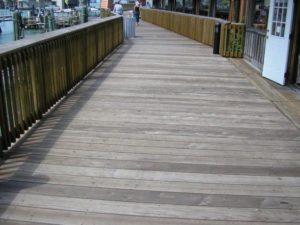 The mad scramble to rebuild the east coast boardwalks after Hurricane Sandy has begun. As usual, many municipalities dragged their feet during the winter, and with tourist season looming just a few months away, our phones are ringing off the hook with people looking for 2×4 and 2×6 Ipe for a boardwalk somewhere along the Atlantic coast. Ipe suppliers such as J. Gibson McIlvain and many of our contemporaries have been stocking up in preparation for this surge, but even then we will see the supply chain severely tested because these commercial projects automatically specify 2x lumber. The overwhelming majority of Ipe produced at the mills falls in the 1x or 5/4 thickness, while 2x material is much rarer. The 2×4 or 2×6 has been the accepted norm for decades with pressure treated lumber, but with Ipe’s more than double bending and stiffness design values, one has to wonder if we are over building these boardwalks, causing sourcing problems and increased costs.
The mad scramble to rebuild the east coast boardwalks after Hurricane Sandy has begun. As usual, many municipalities dragged their feet during the winter, and with tourist season looming just a few months away, our phones are ringing off the hook with people looking for 2×4 and 2×6 Ipe for a boardwalk somewhere along the Atlantic coast. Ipe suppliers such as J. Gibson McIlvain and many of our contemporaries have been stocking up in preparation for this surge, but even then we will see the supply chain severely tested because these commercial projects automatically specify 2x lumber. The overwhelming majority of Ipe produced at the mills falls in the 1x or 5/4 thickness, while 2x material is much rarer. The 2×4 or 2×6 has been the accepted norm for decades with pressure treated lumber, but with Ipe’s more than double bending and stiffness design values, one has to wonder if we are over building these boardwalks, causing sourcing problems and increased costs.
When building a deck or boardwalk, the stiffness of the material is a key factor. This determines how much space between your structural members you can allow based upon the expected load. This metric is known as Modulus of Elasticity or simply the design value E, and it represents a ratio of the amount a material will deflect in proportion to an applied load. Put simply, will the deck “bounce” when you walk across it, and will the wood break if that load is too high. Obviously, when talking about a commercial boardwalk, those loads are very high and at the extreme end of the spectrum, whereas an individual’s personal deck will have a much lower load placed upon it.
So looking just at the raw data, Ipe has a modulus of elasticity that is more than twice that of pressure treated Pine (3.1 M psi vs 1.5 M psi), and therefore, we can assume that half the thickness in Ipe would yield similar performance results. I did some double checking with a few structural engineers, and they agree with me, and then they bombarded me with even more data and additional variables to consider only to achieve the same conclusion. This higher E value means that longer spans can made with thinner boards with the same deflection.
Ipe Span Values under 100 lb Live Load
| 1×4 | 26″ |
| 1×6 | 28″ |
| 5/4×4 | 29″ |
| 5/4×6 | 32″ |
| 2×6 | 48″ |
CCA Pressure Treated Span Values under 100 lb Live Load
| 2×6 | 24″ |
The real wild card in this equation is a serviceability issue and just how much deflection is considered acceptable and how will the much harder Ipe react to greater deflection. A harder wood will have the potential to form cracks when bent too much. Even then, the hard data shows that Ipe should withstand this test too.
All this engineering data aside, I don’t know any builder who is going to take a risk on a high profile project like a boardwalk and deviate from the current specification that is in use now. There are just too many lawyers out there to take a chance, no matter what the data tells us. For that matter, you will never catch J. Gibson McIlvain making the same recommendation for that same reason. When in doubt, overbuilding seems to be a safe mantra.
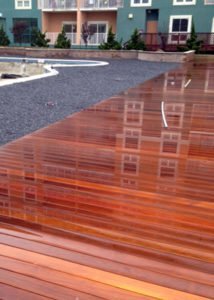
In a perfect world, there would only be a few boardwalks under construction at one time, and the typical supply chain would be able to keep up. The aftermath of Hurricane Sandy has created some issues that we anticipated months ago when we ordered more 2x Ipe, but no matter how much you order, when everyone starts building at the same time, supply will be strained dramatically. So now that we all know that Ipe is so much stronger and the E value will allow us to use at least 5/4 decking, the supply and cost issue will be much easier to address.
Which one of you wants to go first and give it a try? Don’t everybody raise your hand all at once! (cue chirping crickets) Yeah, I didn’t think so.
Unfortunately what has worked so far is what is safe to continue doing, and it makes me wonder what it will take to change this practice or if it ever will? Until then, recognize that longer lead times and increased cost per foot will be the norm on this more unusual size of Ipe. Don’ get me wrong, we (and others) can supply the 2x material. The supply is there, but probably not all at once and not on a 1 week notice.
What Do You Think?
I’m no engineer, so somebody speak up and shoot some holes in this assumption. What am I missing? What would it take for you to spec thinner Ipe on a commercial use project?

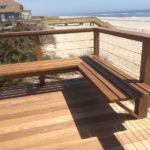
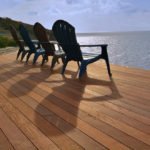
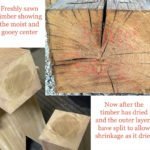
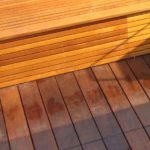
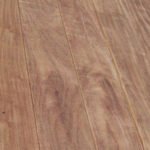
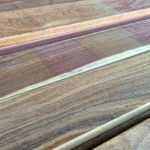


new certified recommendations for its use from the manufacturer or an independent forest services laboratory.
If I’m building below what is generally considered spec – I want someone else to be legally responsible for damages if the product doesn’t standup
I would think that in most cases for boardwalks, the “tie down” of the structure is as important as the download or liveload. The force of a rising sea, wind and waves is tremendous. Therefore more joists strapped to stringers etc would help the uplift and 5/4 will easily handle the E factor. I am not an engineer but I build many decks and other outdoor structures. Uplift is a new focus for the Building Departments here in Ct and NY.
I believe the issue is not the typical load factors of humans walking on the board walk, but they are driving trucks and other service vehicles on some of the boardwalks. I am most pleased that they are choosing wood versus other materials. I sent an article out two months ago that Mayor Blumburg the liberal “green” busy body decided wood was not a good choice and was eliminating it as a choice. He thought cement or other alternatives were better choices. Board Walk = wood walk in my dictionary….
Robert, trucks and snow plows and such were the exact factors that were flagged when I spoke with engineers about this issue. A few suggested that the design values would support the dynamic weight but the snow plow factor was the biggest danger as scratching and tearing the surface obviously introduces a lot of structural issues. All of these issues could be solved with closer joist spacing but then we are talking about a serious rebuild for an existing boardwalk.